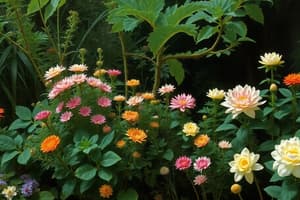Podcast
Questions and Answers
Why did land plants have to adapt to absorb water and nutrients?
Why did land plants have to adapt to absorb water and nutrients?
- To protect their gametes from drying out
- Because water and nutrients are only available in the soil (correct)
- To prevent their tissues from evaporating
- To develop structures to resist wind and weather
What was one of the challenges land plants faced in reproduction?
What was one of the challenges land plants faced in reproduction?
- Developing structures to resist gravity
- Protecting the gametes from drying out
- Absorbing water directly into cells
- Releasing gametes into the water for fertilization (correct)
What is the purpose of the smooth, somewhat slippery, waxy cuticle found on plant tissues?
What is the purpose of the smooth, somewhat slippery, waxy cuticle found on plant tissues?
- To help plants resist wind and weather
- To prevent tissues from evaporating (correct)
- To absorb water and nutrients efficiently
- To protect the gametes from drying out
Why did land plants have to develop structures to help them grow against the force of gravity?
Why did land plants have to develop structures to help them grow against the force of gravity?
What did algae release into the water for fertilization?
What did algae release into the water for fertilization?
Flashcards are hidden until you start studying
Study Notes
Characteristics of Plants
- A plant is a multicellular eukaryote, meaning it is made of cells with a true nucleus and membrane-bound organelles.
- Plants have thick cell walls made of cellulose.
Origin of Plants
- Plants likely evolved from threadlike green algae that lived in ancient oceans.
- Evidence supporting this hypothesis includes the presence of cellulose in both modern algae and plants.
- Plants first appeared in the fossil record over 440 million years ago, with simple, leafless forms.
Adaptations of Plants
- Plants have a waxy waterproof carbohydrate called cellulose in their leaves and stems.
- The cuticle, a coating on the stem, helps reduce water loss.
- Plants are autotrophic, producing their own food through photosynthesis.
- Both plants and green algae use the same type of chlorophyll for photosynthesis and store food as starch.
Studying That Suits You
Use AI to generate personalized quizzes and flashcards to suit your learning preferences.


